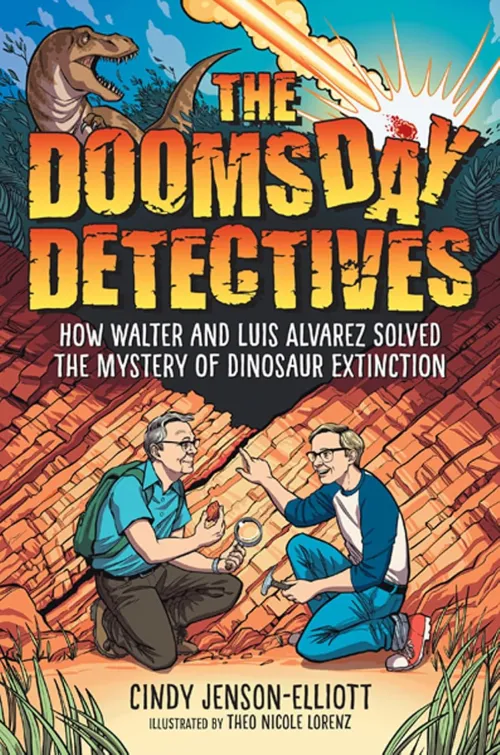Share this book
After reading The Doomsday Detectives, have students apply their understanding of scientific inquiry and content knowledge by creating original science comics. Invite students to choose a topic of interest from the book that they want to explore further and transform it into a multi-panel comic that blends visual storytelling, accurate scientific information, and emotional connection and communicates information in an accessible, memorable way.
Encourage students to pick a clear, focused idea—something that can be effectively explained through a short sequence of scenes—and identify what they want the reader to know, feel, or do after reading the comic. Whether students aim to spark curiosity, explain a new concept, or even shift attitudes about how science works, their comic should aim to make a meaningful impact on the reader’s understanding or perspective.
Before they begin the comic creation process of scripting, storyboarding, and creating final art, students will need to thoroughly research their topic. Throughout the project, push students to think like scientists and communicators—exploring content deeply but also considering how best to teach others through storytelling.
In the scripting phase, direct students to draft concise text, noting anything that can instead be shown visually. With storyboarding, have students sketch simple thumbnails of each panel to plan the flow of their story, identify key scenes, and stay focused on the big picture. Finally, make drawing or digital tools available for students to create their finished comic. Let them know the goal isn’t artistic perfection—expressive stick figures are totally acceptable—but clarity, creativity, and scientific accuracy.
Hold a classroom comic gallery walk or create a digital gallery for students to share their work and celebrate the joys of reading and science.
Questions for Discussion or Reflective Writing
- Why do scientists—and many others—remain so curious about the mass extinction that wiped out the dinosaurs around 66 million years ago? How might findings about this event help us to better understand changes happening on Earth today, especially in terms of climate change and threats to ecosystems?
- Luis encouraged Walter to use his imagination and think big. Why do you think that using your imagination is important in science?
- How does the asteroid impact hypothesis explain the extinction of the dinosaurs and other species? Why was the Alvarez hypothesis initially controversial? What changed to make it the most widely accepted theory for the mass extinction at the end of the Mesozoic Era? What additional observations and findings supported the asteroid impact hypothesis?
- In what ways did Luis Alvarez’s training in physics help him approach the problem of dinosaur extinction differently? What does this show about the value of bringing different perspectives and expertise to answering really big questions?
- How did Luis and Walter Alvarez use the scientific method to test their hypothesis? Why was working together and collaborating with other scientists key to their process? How does learning about how they worked affect your understanding of the scientific process?
- What is iridium, and where is it commonly found? Why was its presence in certain rock layers around the world such an important clue in the Alvarez hypothesis?
- Where does volcanic activity fit into the conversation about what caused the dinosaurs’ extinction? How might both asteroid impact and volcanism have contributed to the mass extinction?
- What is evolution through natural selection? What does the asteroid impact teach us about evolution?
Related Resources
The Doomsday Detectives Teacher’s Guide from Lee & Low Books
Dinosaurs: Activities and Lesson Plans from the American Museum of Natural History
The Day the Mesozoic Died from Howard Hughes Medical Institute (HHMI) Biointeractive
Science Comics: A Creative Gateway Into Literacy and STEM from Science Friday
xkcd: A webcomic of romance, sarcasm, math, and language from Randall Munroe
More Titles to Try
-
Digging Deep: How Science Unearths Puzzles from the Past
Laura Scandiffio
-
Extinctopedia: Discover What We Have Lost, What Is at Risk, and How We Can Preserve the Diversity of Our Fragile Planet
Serenella Quarello
-
The First Dinosaur: How Science Solved the Greatest Mystery on Earth
Ian Lendler
-
Gutsy Girls Go for Science: Paleontologists
Karen Bush Gibson
-
Peter Lee's Notes from the Field
Angela Ahn
-
T-Rex and the Crater of Doom
Walter Alvarez
Stay on top of current education news



